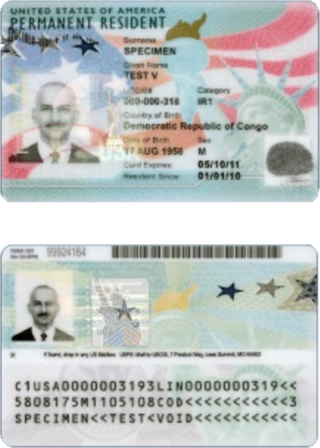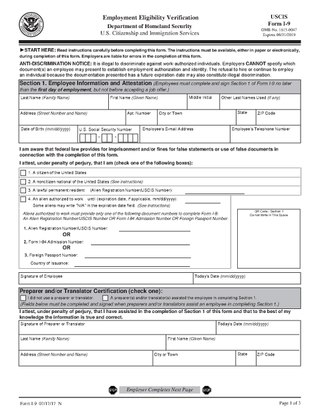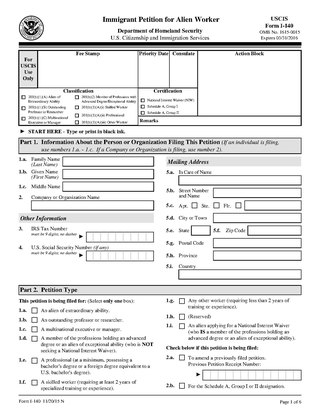
A green card, known officially as a permanent resident card, is an identity document which shows that a person has permanent residency in the United States. Green card holders are formally known as lawful permanent residents (LPRs). As of 2019, there are an estimated 13.9 million green card holders, of whom 9.1 million are eligible to become United States citizens. Approximately 65,000 of them serve in the U.S. Armed Forces.
The H-1B is a visa in the United States under the Immigration and Nationality Act, section 101(a)(15)(H) that allows U.S. employers to employ foreign workers in specialty occupations. A specialty occupation requires the application of specialized knowledge and a bachelor's degree or the equivalent of work experience. The duration of stay is three years, extendable to six years, after which the visa holder may need to reapply. Laws limit the number of H-1B visas that are issued each year. There exist congressionally mandated caps limiting the number of H-1B visas that can be issued each fiscal year, which is 65,000 visas, and an additional 20,000 set aside for those graduating with master’s degrees or higher from a U.S. college or university. Individuals cannot apply for H-1B visas on their own to allow them to work in the U.S. An employer must sponsor them for the visa. There were 206,002 new and initial H-1B visas were issued in 2022.
An L-1 visa is a visa document used to enter the United States for the purpose of work in L-1 status. It is a non-immigrant visa, and is valid for a relatively short amount of time, from three months to five years, based on a reciprocity schedule. With extensions, the maximum stay is seven years.
TN status is a special non-immigrant classification of foreign nationals in the United States, which offers expedited work authorization to a citizen of Canada or a national of Mexico. It was created as a result of provisions of the North American Free Trade Agreement that mandated simplified entry and employment permission for certain professionals from each of the three NAFTA member states in the other member states. The provisions of NAFTA relevant to TN status were then carried over almost verbatim to the United States–Mexico–Canada Agreement that replaced NAFTA in 2020.

Parole, in the immigration laws of the United States, generally refers to official permission to enter and remain temporarily in the United States, under the supervision of the U.S. Department of Homeland Security (DHS), without formal admission, and while remaining an applicant for admission.

The visa policy of the United States consists of the requirements for foreign nationals to travel to, enter, and remain in the United States. Visitors to the United States must obtain a visa from one of the U.S. diplomatic missions unless they come from one of the visa-exempt or Visa Waiver Program countries. The same rules apply for travel to all U.S. states, Washington, D.C., Puerto Rico and the U.S. Virgin Islands, as well as to Guam and the Northern Mariana Islands with additional waivers, while similar but separate rules apply to American Samoa.

Form I-9, officially the Employment Eligibility Verification, is a United States Citizenship and Immigration Services form. Mandated by the Immigration Reform and Control Act of 1986, it is used to verify the identity and legal authorization to work of all paid employees in the United States. All U.S. employers must ensure proper completion of Form I-9 for each individual they hire for employment in the United States.
An H-4 visa is a United States visa issued to dependent family members of H-1B, H-1B1, H-2A, H-2B, and H-3 visa holders to allow them to travel to the United States to accompany or reunite with the principal visa holder. A dependent family member is a spouse or unmarried child under the age of 21. If a dependent of an H-1B, H-1B1, H-2A, H-2B, or H-3 worker is already in the United States, they can apply for H-4 immigration status by filing Form I-539 for change of status with United States Citizenship and Immigration Services (USCIS).
The Security Through Regularized Immigration and a Vibrant Economy Act of 2007 or STRIVE Act of 2007 is proposed United States legislation designed to address the problem of illegal immigration, introduced into the United States House of Representatives. Its supporters claim it would toughen border security, increase enforcement of and criminal penalties for illegal immigration, and establish an employment verification system to identify illegal aliens working in the United States. It would also establish new programs for both illegal aliens and new immigrant workers to achieve legal citizenship. Critics allege that the bill would turn law enforcement agencies into social welfare agencies as it would not allow CBP to detain illegal immigrants that are eligible for Z-visas and would grant amnesty to millions of illegal aliens with very few restrictions.
An L-2 visa is a visa document used to enter the United States by the dependent spouse and unmarried children under 21 years of age of qualified L-1 visa holders. It is a non-immigrant visa, and is only valid for the duration of the spouse's L-1 visa.
Temporary protected status (TPS) is given by the United States government to eligible nationals of designated countries, as determined by the Secretary of Homeland Security, who are present in the United States. In general, the Secretary of Homeland Security may grant temporary protected status to people already present in the United States who are nationals of a country experiencing ongoing armed conflict, an environmental disaster, or any temporary or extraordinary conditions that would prevent the foreign national from returning safely and assimilating into their duty. Temporary protected status allows beneficiaries to live and, in some cases, work in the United States for a limited amount of time. As of March 2022, there are more than 400,000 foreign nationals in Temporary Protected Status.

The Border Security, Economic Opportunity, and Immigration Modernization Act of 2013 was a proposed immigration reform bill introduced by Sen. Charles Schumer (D-NY) in the United States Senate. The bill was co-sponsored by the other seven members of the "Gang of Eight", a bipartisan group of U.S. Senators who wrote and negotiated the bill. It was introduced in the Senate on April 16, 2013 during the 113th United States Congress.
Form I-129, Petition for a Nonimmigrant Worker is a form submitted to the United States Citizenship and Immigration Services used by employers or prospective employers to obtain a worker on a nonimmigrant visa status. Form I-129 is used to either file for a new status or a change of status, such as new, continuing or changed employer or title; or an amendment to the original application. Approval of the form makes the worker eligible to start or continue working at the job if already in the United States. If the worker is not already in the United States, an approved Form I-129 may be used to submit a visa application associated with that status. The form is 36 pages long and the instructions for the form are 29 pages long. It is one of the many USCIS immigration forms.
The United States Citizenship and Immigration Services (USCIS) issues a number of forms for people to submit to them relating to immigrant and non-immigrant visa statuses. These forms begin with the letter "I". None of the forms directly grants a United States visa, but approval of these forms may provide authorization for staying or extending one's stay in the United States as well as authorization for work. Some United States visas require an associated approved USCIS immigration form to be submitted as part of the application.
Form I-539, Application to Extend/Change Nonimmigrant Status is one of the forms issued by the United States Citizenship and Immigration Services. It is used by people currently in the United States in a non-immigrant status to change the classification for their status and/or extend their stay with their current status. Both the current status and the status to which the transition is being sought must be non-immigrant visa statuses.
The Legal Immigration Family Equity Act of 2000, also known as the LIFE Act and as the Legal Immigration and Family Equity Act, along with its Amendments, made some changes to laws surrounding immigration for family members of United States citizens and Lawful Permanent Residents, as well as people eligible for employment-based immigrant visas, in the direction of making it easier for family members and immigrant workers to move to and adjust status within the United States. It was passed on December 21, 2000, as title XI of Pub. L. 106–553 (text)(PDF).

Form I-140, Immigrant Petition for Alien Worker is a form submitted to the United States Citizenship and Immigration Service (USCIS) by a prospective employer to petition an alien to work in the US on a permanent basis. This is done in the case when the worker is deemed extraordinary in some sense or when qualified workers do not exist in the US. The employer who files is called the petitioner, and the alien employee is called the beneficiary; these two can coincide in the case of a self-petitioner. The form is 6 pages long with a separate 10-page instructions document as of 2016. It is one of the USCIS immigration forms.

Systematic Alien Verification for Entitlements (SAVE) is a program managed by United States Citizenship and Immigration Services (USCIS), a branch of the U.S. Department of Homeland Security (DHS). SAVE facilitates lookups on the immigration and nationality status of individuals in the United States. It is an intergovernmental initiative designed to help federal, state, tribal, and local government agencies, or by a contractor acting on the agency's behalf, to determine eligibility for benefits, licenses or grants, government credentials, or to conduct background investigations. It is one of two programs that uses the Verification Information System (VIS). The other program is the Electronic Employment Eligibility Verification Program, also known as E-Verify, and is used by employers to verify the immigration status of employees. For additional verification, SAVE relies on the Person Centric Query System (PCQS).
The R-1 visa is a non-immigrant visa which allows travel to the United States for service as a minister or other religious occupation. Between October 2019 and September 2020, there were 2,399 R visas issued.

The U.S. Citizenship Act of 2021 was a legislative bill that was proposed by President Joe Biden on his first day in office. It was formally introduced in the House by Representative Linda Sánchez. It died with the ending of the 117th Congress.









